
| Home | Deepsky Atlas | TheAstronews | Links | Solar System | ||||||

Hawaiian Astronomical SocietyConstellations: Hydra -- Many Heads with one Thought |
||||||||||
Hercules brought his nephew Iolaus (son of his twin brother Iphicles) as his assistant. This creature with nine heads lived in a swamp. Its mere breath could kill a person. Hercules shot a fire-arrow into the Hydra's den to lure the monster out, while Iolaus set the nearby shrubs on fire to confuse the creature.
Killing Hydra was easier said than done, since one of the heads was immortal and the others were almost as bad. As Hercules chopped off one, two new heads grew up to replace them. It was Iolaus who suggested burning the stumps before they had a chance to grow back. Hercules and Iolaus made a great team. The uncle chopped heads; the nephew burned the stumps before the new ones grew.
When all mortal heads had been chopped and burned, Hercules disposed of the one that was immortal by burying it securely under a gigantic rock. Hercules had accomplished his second labor. As a reward, he dipped his arrows in the monster's blood. Even a grazing shot from one of those arrows would kill.
Click here for the next labor.
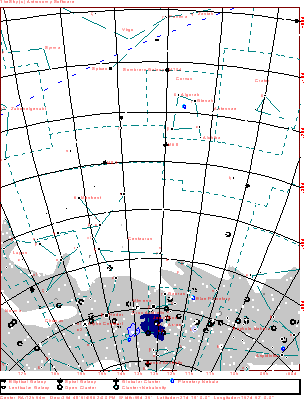
Click the maps for a 916x1200 version of the above. Click here for a map better suited for use in the field.
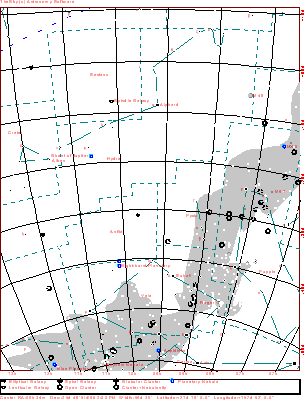
Click here for a map better suited for use in the field.
Starting at the Hydra's tail, and proceeding west and north to its head these maps display stars to magnitude 10, and deepsky objects to magnitude 12.
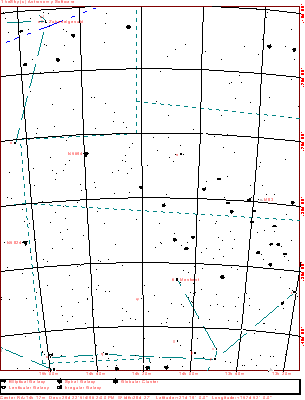
Click here for a map better suited for use in the field.
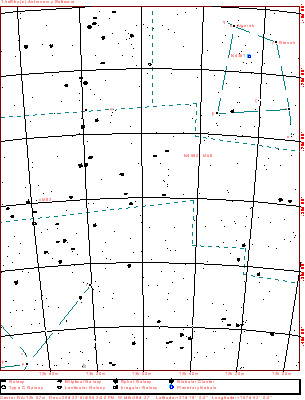
Click here for a map better suited for use in the field.
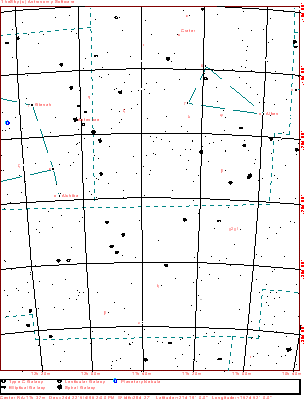
Click here for a map better suited for use in the field.
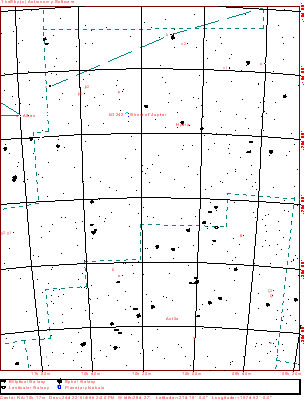
Click here for a map better suited for use in the field.
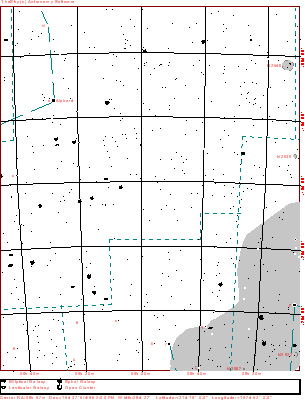
Click here for a map better suited for use in the field.
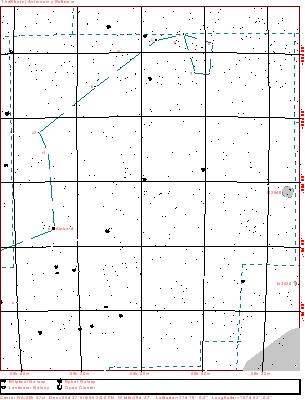
Click here for a map better suited for use in the field.
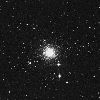 22k JPEG NGC5694 (Caldwell 66) is a globular cluster located 7.4° east of Pi Hydrae and 5.6° WSW of Sigma Librae, placing it at the tip of the monster's tail. Dreyer calls it quite bright (mag. 10.2), quite small (3.6'), with a pronounced core. He also gives it a single "r," meaning it is somewhat resolvable. Dark skies and a large scope help bring out the faint, powdery stars. This is a distant globular. Image from the Digital Sky Survey. 22k JPEG NGC5694 (Caldwell 66) is a globular cluster located 7.4° east of Pi Hydrae and 5.6° WSW of Sigma Librae, placing it at the tip of the monster's tail. Dreyer calls it quite bright (mag. 10.2), quite small (3.6'), with a pronounced core. He also gives it a single "r," meaning it is somewhat resolvable. Dark skies and a large scope help bring out the faint, powdery stars. This is a distant globular. Image from the Digital Sky Survey.
|
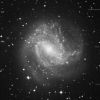 93k JPEG M83 (NGC5236, Bennett 63) is a barred spiral galaxy located in the tail of Hydra, about 19° south of Spica (the brightest star of Virgo). Dreyer describes it as very bright (mag. 8.5), very large (11'x10'), and elongated in position angle (PA) 55°. From the Digital Sky Survey. A final note: The brighter (mag. 16) of the two faint galaxies to the left is ESO444-85 93k JPEG M83 (NGC5236, Bennett 63) is a barred spiral galaxy located in the tail of Hydra, about 19° south of Spica (the brightest star of Virgo). Dreyer describes it as very bright (mag. 8.5), very large (11'x10'), and elongated in position angle (PA) 55°. From the Digital Sky Survey. A final note: The brighter (mag. 16) of the two faint galaxies to the left is ESO444-85
|
 8k JPEG Another image of M83 from the CCD Image Archives. Pedro Ré took this with a HISYS22 and a C-14 at f6. Two, five minute exposures. 8k JPEG Another image of M83 from the CCD Image Archives. Pedro Ré took this with a HISYS22 and a C-14 at f6. Two, five minute exposures.
|
 44k Labeled JPEG Three major galaxies occupy one degree of sky about 3.8° south of Gamma Hydrae in the eastern part of the constellation. NGC5061 (Bennett 59) sits one degree north-west of the other two. Dreyer describes it as very bright (mag. 10.3), small (3.5'x3.0'), round, with a very abruptly much brighter middle. A 9th magnitude star lies 2' eastward. 44k Labeled JPEG Three major galaxies occupy one degree of sky about 3.8° south of Gamma Hydrae in the eastern part of the constellation. NGC5061 (Bennett 59) sits one degree north-west of the other two. Dreyer describes it as very bright (mag. 10.3), small (3.5'x3.0'), round, with a very abruptly much brighter middle. A 9th magnitude star lies 2' eastward.
NGC5101 lies one degree south-west. Described as quite bright (mag. 10.6), fairly small (5.4'x4.5'), little extended, with a fairly abruptly brighter middle star. Observers today call it a stellar nucleus; no-one was certain of the true nature of galaxies in Dreyer's day. NGC5078 lies 26' west of NGC5101. Dreyer's description reads: Fairly bright (11.5), fairly small (3.9'x1.9'), considerably extended (177°), and a fairly abruptly brighter middle. A star of magnitude 7 or 8 lies to the east. IC879, a very faint galaxy shining at mag. 14 (photographic), lies about 3' south-west.
Image from the Digital Sky Survey. Countless galaxies inhabit the image, especially the larger version below.
|
 10k JPEG M68 (NGC4590, Bennett 51) is a large (12'), extremely rich globular cluster located 3.5° SSE of Beta Corvi. Shining at a combined magnitude of 8.2, its stars resolve at mag. 12-13. From the CCD Image Archives. Pedro Ré took this with a HISYS22 and a C-14. Two, three minute exposures. 10k JPEG M68 (NGC4590, Bennett 51) is a large (12'), extremely rich globular cluster located 3.5° SSE of Beta Corvi. Shining at a combined magnitude of 8.2, its stars resolve at mag. 12-13. From the CCD Image Archives. Pedro Ré took this with a HISYS22 and a C-14. Two, three minute exposures.
|
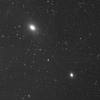 80k JPEG Two galaxies occupy the same low power field. NGC3923 (Bennett 49) is described as bright (mag. 10.5), fairly large (5.9'x3.9'), little extended, gradually much brighter toward the middle, and "resolvable," meaning a 12" may show mottling under good conditions. There is a very faint star southwest involved. 80k JPEG Two galaxies occupy the same low power field. NGC3923 (Bennett 49) is described as bright (mag. 10.5), fairly large (5.9'x3.9'), little extended, gradually much brighter toward the middle, and "resolvable," meaning a 12" may show mottling under good conditions. There is a very faint star southwest involved.
NGC3904 lies 37' south-west of NGC3923. The NGC Catalog lists it as fairly bright (mag. 11.8), small (2.7'x2.0'), round, with a much brighter middle.
Image from the Digital Sky Survey.
|
NGC3606 sits 1.1° SSW of NGC3621. It is a mag. 13.4 galaxy made easier to see by its small size (1.5').
Image on the left was taken with an ST6 on a C-14 at Grove Creek Observatory. It is a combination of 30, 30 second exposures at f7. Image on the right is a mosaic made from the Digital Sky Survey.
|
|
 21k JPEG M48 (NGC2548) is a very large (54'), fairly rich open cluster located 18.5° WNW of Alphard. Shining at a combined magnitude of 5.8, its stars resolve at mag. 9-13. From the CCD Image Archives. Pedro Ré took this with a HiSYS22 and a 4" Meade at f6.3. Two, two minute exposures. 21k JPEG M48 (NGC2548) is a very large (54'), fairly rich open cluster located 18.5° WNW of Alphard. Shining at a combined magnitude of 5.8, its stars resolve at mag. 9-13. From the CCD Image Archives. Pedro Ré took this with a HiSYS22 and a 4" Meade at f6.3. Two, two minute exposures.
|
If you have any questions about the Hawaiian Astronomical Society
please
(link requires javascript).